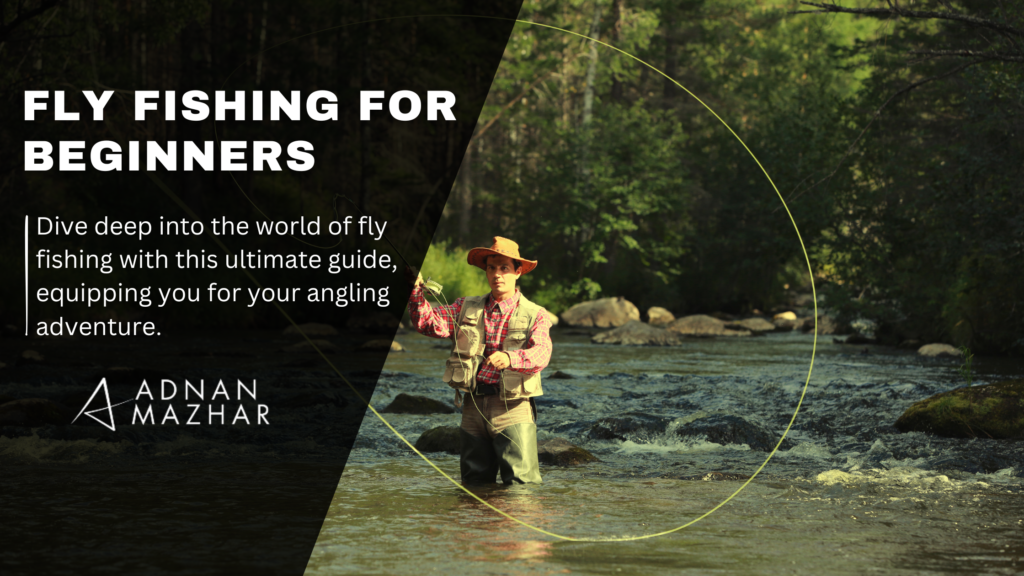
Fly fishing transcends the act of simply catching fish. To start fly fishing is to embark on a journey of learning and discovery, navigating through the complexities of gear and technique.
It’s a meditative dance with nature, a meticulous choreography of technique and finesse, where the right fly fishing gear becomes an extension of the angler’s intent.
Mastering this art form unlocks a world of hidden beauty in serene rivers and glassy lakes, rewarding you with exhilarating strikes and moments of peaceful solitude.
Understanding the basics of your fly fishing setup is crucial, and this guide is here to cover the essentials needed to get started.
This comprehensive guide delves deep into the world of fly fishing, equipping you with the knowledge and skills to embark on your own angling adventure.
Whether you’re a complete novice or an aspiring enthusiast, this resource will be your companion on the path to becoming a skilled fly fisher.
The Enchantment of Starting Fly Fishing for Beginners

Beyond the thrill of the catch, fly fishing offers a unique connection with the natural world. Unlike its bait-and-weight counterparts, fly fishing prioritizes presentation over brute force. The flies themselves are works of art, meticulously crafted to imitate the natural food sources of fish.
Watching a trout rise to a perfectly presented fly, mistaking it for a real insect, is a testament to the effectiveness and artistry of this technique.
The rhythmic dance of casting the fly line, the gentle plop as it lands on the water, the delicate tugs and subtle takes – fly fishing is an experience that engages all your senses.
It’s a chance to escape the hustle and bustle of everyday life, immersing yourself in the serenity of nature. With every cast, you become part of a timeless tradition practiced by anglers for centuries.
It’s these moments that elevate fly fishing to more than just a sport, offering a gateway to diverse fly fishing adventures around the globe.
Fly Fishing Gear and Equipment
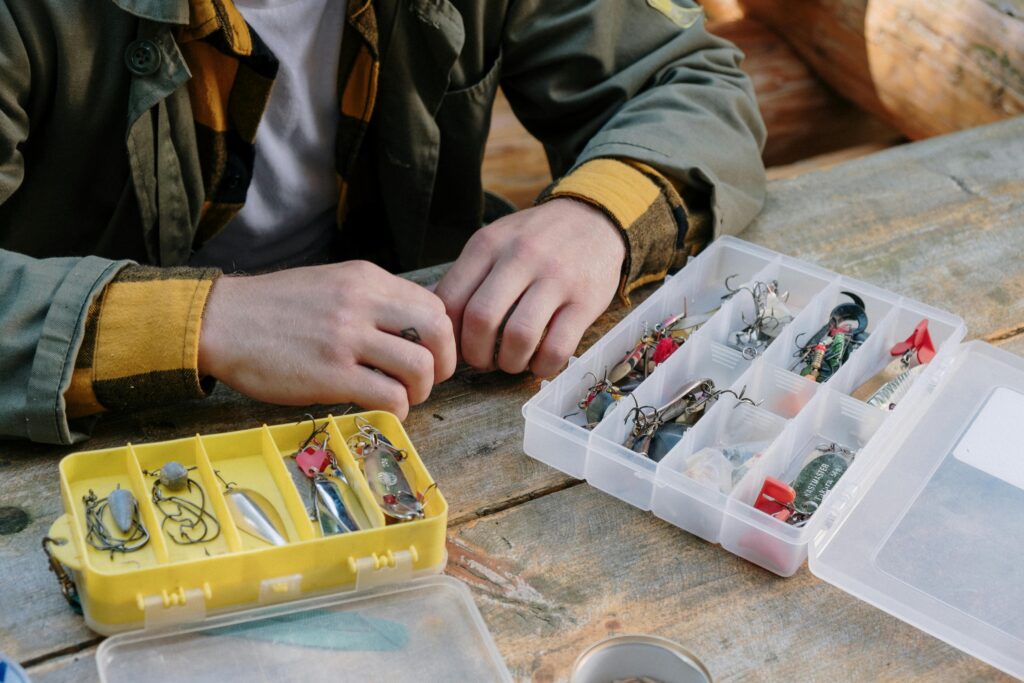
Before casting your line into the water, it’s crucial to understand the tools that will become extensions of your body on this journey. Fly fishing relies on a specialized set of equipment, each component playing a vital role in the overall success:
- The Fly Fishing Rod: Your fly fishing rod is the backbone of the fly-fishing setup, acting as the conductor of the fly fishing orchestra. Choose a lightweight yet powerful rod that feels comfortable in your hand and matches the size and type of fish you’ll be targeting. When selecting fly rods, beginners should consider common lengths that range from 7 feet for smaller streams to 9 feet for larger bodies of water, keeping in mind the best fly rod length and weight for their specific fishing scenarios. Material choices include graphite for a balance of lightness and strength, or fiberglass for a more forgiving feel for beginners.
- The Fly Reel: Don’t underestimate the importance of the reel. Unlike spinning reels, fly reels manage the thin fly line with minimal resistance. Look for a reel with a smooth drag system that allows the fish to take line without snapping the tippet (the thinnest section of line). Consider features like a large arbor for faster line retrieval and a clicker to alert you when a fish takes the fly.
- The Fly Line: The fly line acts as a bridge between your rod and the fly, transmitting the casting energy and allowing for smooth line control. Fly lines play a crucial role in casting and presentation, with their designations and components significantly impacting the fishing experience. Floating lines are the most common choice, designed to keep the fly at the surface of the water. Sinking lines are used for reaching deeper depths, while shooting heads are helpful for achieving longer casts on windy days.
- The Leader and Tippet: The leader is a transparent section of line that connects the fly line to the even finer tippet. It provides a transition in strength and helps with casting presentation. Tippet material is typically fluorocarbon for invisibility in the water and comes in various strengths matched to the targeted fish size.
- Flies, the Allure of Deception: Flies are the heart and soul of fly fishing. These captivating creations come in a mind-boggling array of shapes, sizes, and colors, meticulously designed to imitate a variety of aquatic insects, baitfish, and other food sources for fish. Dry flies mimic insects resting on the water’s surface, while nymphs and streamers represent insects or baitfish swimming below. Popular fly patterns include Wooly Buggers, Clouser Deep Minnows, Adams Parachutes, and Royal Wulffs.
Essential Techniques

Now that you’re familiar with the tools, let’s delve into the techniques that will transform you from a novice to a skilled fly fisher:
- Casting: The art of casting a fly line is a skill that takes practice to perfect. It involves a series of controlled motions using your wrist and arm to propel the line and fly through the air. Mastering different casting techniques like the roll cast, overhead cast, and reach mend will allow you to present your fly accurately in various situations, enhancing your ability to catch fish.
- Mending: Imagine casting a perfect presentation, only to have the fly line drag unnaturally behind it. Mending comes to the rescue! This technique involves manipulating the fly line mid-cast to correct its direction or presentation on the water. By using short, controlled movements of the rod tip, you can keep your fly drifting naturally, mimicking the movement of its real-life counterpart.
- Dry Fly Fishing: This style of fly fishing involves presenting a dry fly on the water’s surface to imitate insects that trout feed on, such as mayflies or caddisflies. It’s a visually exciting technique that requires matching the hatch with precision to fool wary trout.
- Stripping: Once your fly lands on the water, it’s time to breathe life into it. Stripping involves retrieving the fly line in short, controlled jerks or pulls that simulate the movement of the insect or baitfish it represents. Different stripping techniques can be used depending on the fly pattern and the desired action. Short, quick strips work well for imitating struggling insects, while slower, deliberate pulls can mimic a baitfish swimming leisurely. Experimenting with different stripping rhythms will help you entice various fish species and is especially effective when streamers are fly fished.
- Setting the Hook: The moment of truth arrives! When a fish takes your fly, you’ll feel a tug or a change in line tension. Resist the urge to yank the rod – a sharp but controlled upward motion is key. This sets the hook in the fish’s mouth without tearing its jaw. Once hooked, playing the fish requires patience and finesse. Let the fish run but maintain tension on the line, guiding it towards you gradually. Utilize the rod’s flexibility to tire the fish out before carefully bringing it to hand.
A Responsible Angler’s Guide
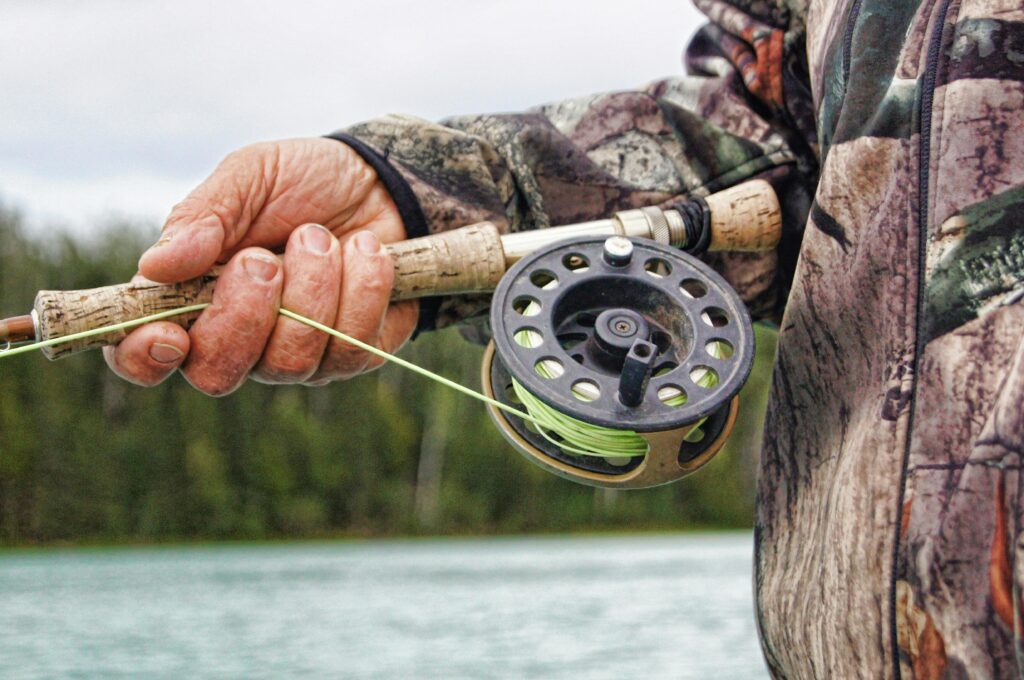
Fly fishing often takes place in remote and beautiful locations. While immersing yourself in nature is part of the charm, prioritizing safety is paramount:
- Wading Essentials: Proper wading gear is crucial if you plan to venture into the water. Invest in a sturdy pair of waders with built-in boots and a wading staff for balance and support. Be mindful of the water depth and current strength, and never wade alone.
- Knots and Line Management: Mastering essential knots like the clinch knot and the improved clinch knot will ensure your fly is securely attached to the tippet. Learning line management techniques like stripping the line through the rod guides and coiling it neatly will prevent tangles and frustration.
- Respecting the Environment: Fly fishing is a privilege, and with that privilege comes responsibility. Practice catch-and-release techniques whenever possible to ensure the sustainability of fish populations. Research and follow local fishing regulations regarding size and bag limits for specific species. Leave no trace behind by packing out all your trash and being mindful of the delicate ecosystem you’re exploring.
Advanced Techniques and Refinement
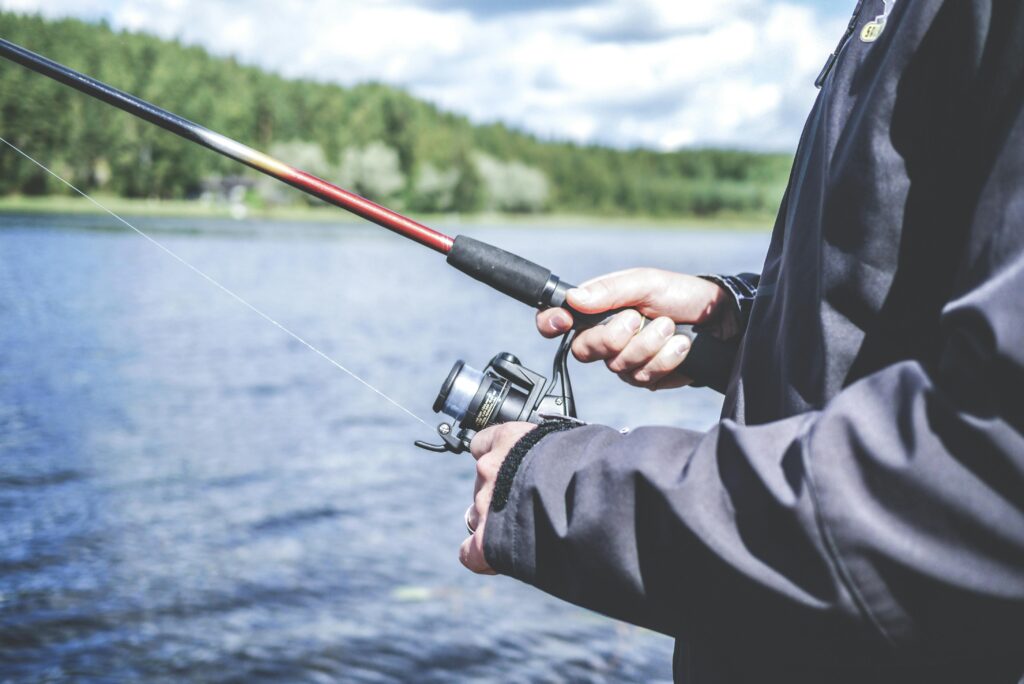
As you gain experience, you can explore advanced techniques to elevate your fly fishing game:
- Reading the Water: Learning to “read” the water is an essential skill for any fly fisherman. Look for signs of fish activity like rising forms (trout feeding on the surface), hatches (emergence of insects from the water), or feeding lanes (areas where fish congregate to feed). Understanding water currents, bottom composition, and aquatic vegetation will help you position yourself strategically for optimal fly presentation. This knowledge is particularly beneficial for beginner fly fishermen looking for areas in the river where the current brings food to fish.
- Fly Selection: Choosing the right fly for the conditions is a crucial aspect of fly fishing success. Factors to consider include the type of fish you’re targeting, the time of year, weather conditions, and the prevailing insect hatches. Mastering fly selection takes time and experience, but observing the insects present on the water and consulting with experienced anglers can be a great starting point. Recommending the best fly rod for a beginner fly fisherman and suggesting specific fly patterns for the beginner fly fisherman to use to trick fish that refuse a traditional dry fly are also important.
- Presentation Matters: A perfectly presented fly can make all the difference. Experiment with different casting techniques and stripping rhythms to achieve a natural, lifelike presentation that entices fish to strike. Factors like drag (unnatural movement of the fly line caused by current) and slack (allowing the fish to take the fly without feeling resistance) play a vital role in presentation. Mastering the specialized vocabulary and terminology, or ‘fly fishing lingo’, is part of refining your fly fishing skills. A ‘Fly Fishing Lingo Dictionary’ provided by Redington Fly Fishing can help in understanding the specific jargon and expressions commonly used in the fly fishing community.
- Double Hauls and Roll Casting: As you progress, advanced casting techniques like double hauls and roll casting can come into play. Double hauls utilize a quick double pull of the line with the non-dominant hand to achieve greater casting distance. Roll casting is a short-distance casting technique ideal for tight spaces or situations with limited back-cast room. Mastering these techniques takes dedicated practice but can significantly improve your fly presentation and casting efficiency.
The Art of Creating Your Own Allure with a Fly Fishing Rod

For the truly passionate angler, fly tying offers a whole new level of engagement with the sport. Tying your own flies allows you to customize them to specific fishing conditions and unleash your creativity.
Learning basic fly tying techniques opens a world of possibilities, allowing you to experiment with different materials and patterns to create unique and effective flies.
A Community of Passionate Anglers
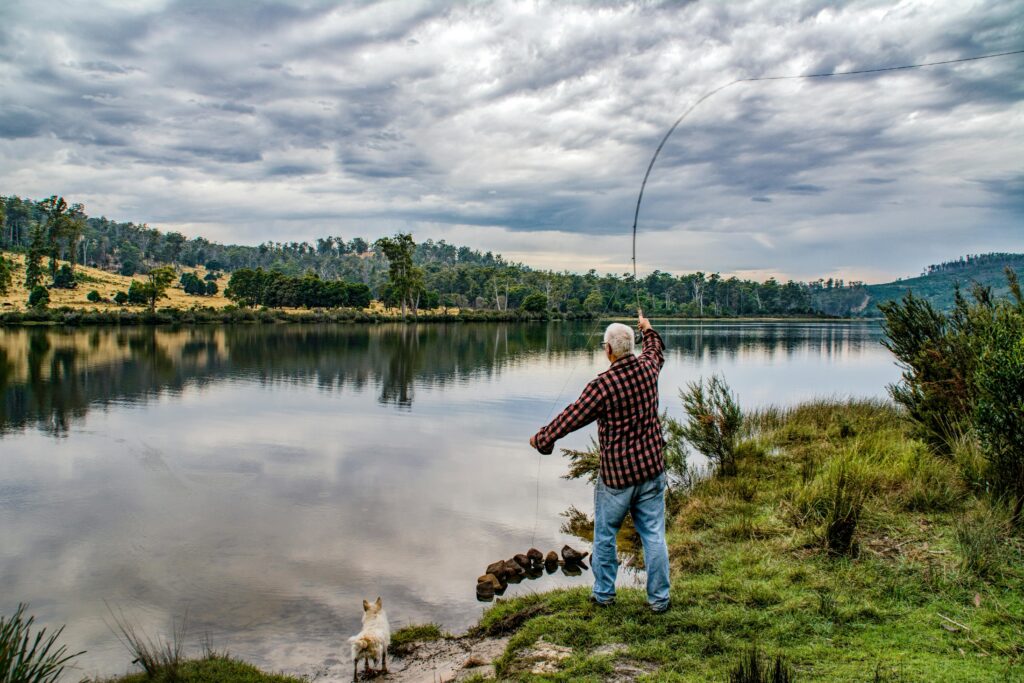
Fly fishing is more than just a solitary pursuit; it’s a community built on a shared love for the outdoors and the thrill of the catch. Consider joining a local fly fishing club or online forum to connect with other anglers, learn valuable tips and tricks, and share your experiences.
Participating in guided fly fishing trips can be a fantastic way to learn techniques from experienced professionals and explore new fishing grounds.
Additionally, visiting a local fly shop can be an invaluable part of joining the community, offering a wealth of knowledge and advice from seasoned fly fishermen.
Conclusion
The world of fly fishing awaits you, brimming with challenges, rewards, and moments of pure serenity. With dedication, practice, and the knowledge contained within this guide, you’ll be well on your way to becoming a skilled fly fisher.
Among these challenges is the exciting world of saltwater fly fishing, offering a unique adventure targeting species in the oceans and tropics. Remember, the journey is just as important as the destination.
Embrace the learning process, savor the beauty of nature, and respect the delicate ecosystem you’re exploring. Cast off, and discover the magic of fly fishing for yourself! Tight lines and happy fishing!


